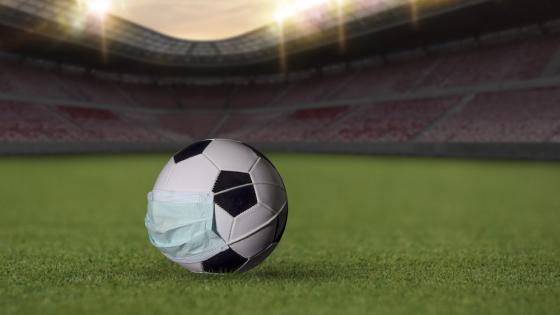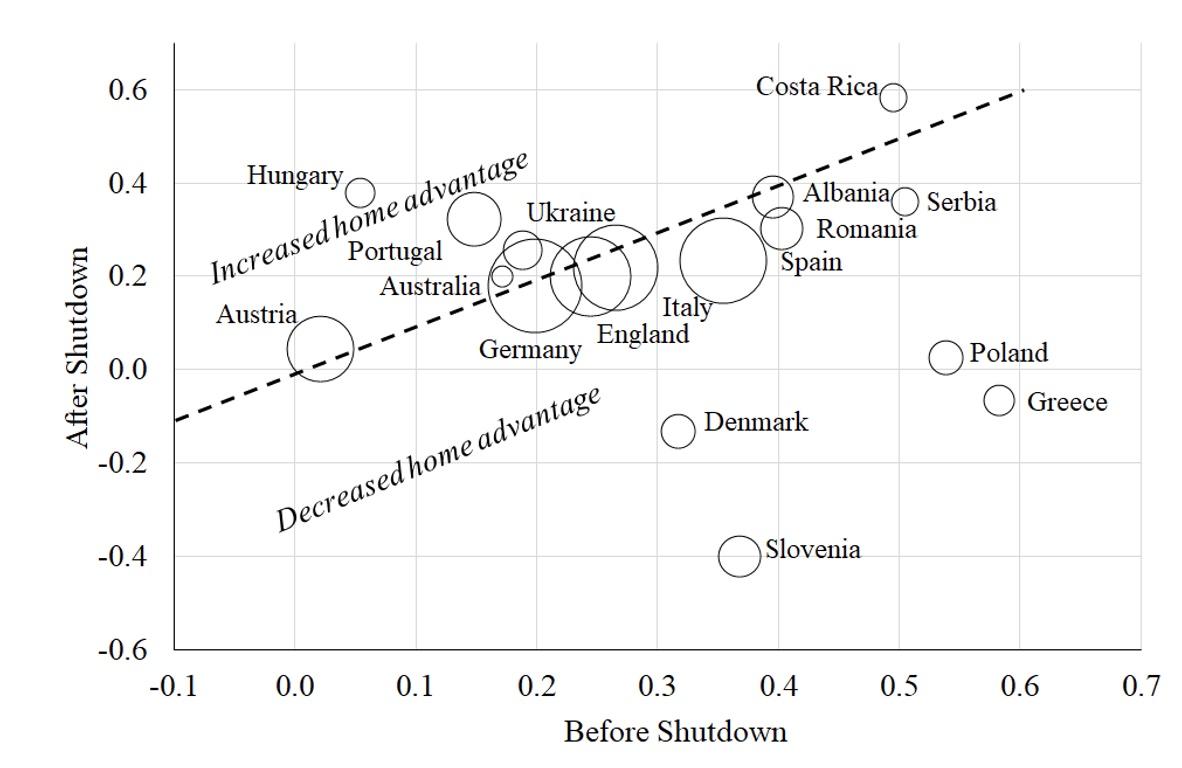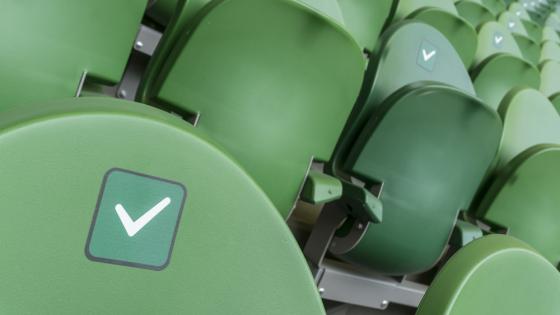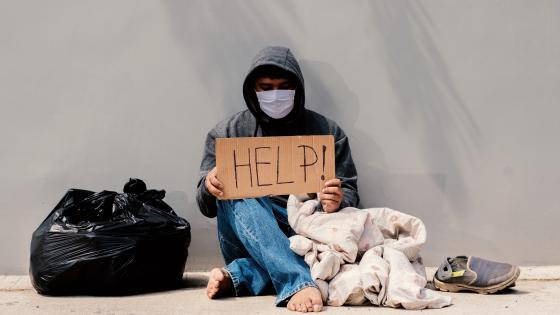Sport can offer rare moments of clarity to social scientists within an otherwise complex real world. The competitive environments in sport provide laboratories to study human behaviour, to test theories, and to observe the effects of policy (Bar-Eli et al. 2020). Economists have been studying the impacts of Covid-19 on sport – and vice versa – addressing research questions that have important implications far beyond the fields of play.
Do sports events significantly cause the spread of Covid-19?
There was surprisingly little evidence on the causal effects that sports events could have on the spread of an airborne virus (notable exceptions are Stoecker et al. 2016 and Cardazzi et al. 2020, both studying seasonal influenza in North America). The first study of whether major sports events can cause the spread of Covid-19 focused on North America (Ahammer et al. 2020). By exploiting the variation in the scheduling of NBA and NHL games in a 12-day period in early March 2020, the study estimated the effects of these large indoor gatherings on the subsequent spread and mortality of Covid-19. The authors concluded that each of these mass gatherings, on average, increased the cumulative number of deaths directly from Covid-19 by 9% up to the end of April 2020, in the areas around where the events took place.
Using a similar empirical design, another study has looked at the impact of English football matches taking place with crowds as the pandemic took hold (Olczak et al. 2020). Even though these events took place outdoors, compared to the indoor events studied in North America, the authors also concluded that attendance at matches resulted in local increases in the spread of Covid-19. Each match added six Covid-19 cases, two Covid-19 deaths, and three excess deaths per 100,000 local people (Figure 1). This small literature, on the potential of sports events to spread the virus, suggests that extreme caution needs to be applied by policymakers on when and how to re-open sports stadiums to spectators.
Figure 1 Summary of regression results of football match activity on mortality in the first half of 2020 in England
Notes: Each column of plots relates to a measure of mortality (Covid-19 cases, Covid-19 deaths, and excess deaths), the top row is without any control variables, and the bottom row adds control variables. Solid dots are regression coefficients on the footballing measure, and circles are the upper and lower confidence intervals (90% significance level).
Source: Olczak et al. (2020)
Does the virus keep sports fans away from stadiums?
The demand for attending sports events during the pandemic may tell us something about how populations respond to a public health emergency, especially one that requires social distancing. It may provide more general evidence on how individuals respond to risk and uncertainty.
Since most governments shut down professional sports quickly in Spring 2020 and subsequently restricted the numbers of fans allowed to return, with massive unmet demand, opportunities to gain novel insights from stadium attendances have so far been limited. Reade and Singleton (2020a) used the predetermined scheduling of football matches in early 2020 in Europe’s major leagues, to test whether public news about domestic or global virus cases and deaths affected stadium attendances. The study found no negative demand association between the global news about the progress of the outbreak and stadium attendance demand. There was mixed evidence that the previous day’s newly confirmed domestic cases or deaths affected attendances, only appearing to do so in England, Germany and Italy.
In the only European professional football league not to shut down temporarily due to Covid-19, Belarussian stadium attendance demand declined significantly in the initial period of maximum uncertainty about the virus and its lethality (Reade et al. 2020a). Demand in this league then slowly recovered, despite the ongoing inherent risks. This would be consistent with a survey of sports fans in North America in August-September 2020, who were largely still willing to accept Covid-19 risks to attend stadiums, but who also demonstrated a substantial increased willingness-to-pay if safety restrictions were in place, especially mask-wearing (Humphreys et al. 2020).
Does the lack of social pressure from crowds affect decisions and bias?
There is widespread evidence that referees of sporting contests are affected by social pressure (Dohmen and Sauermann 2016). The substantial advantage that football teams normally have when playing at home, mostly in front of their own supporters, is partly attributable to the impact the crowd has on refereeing decisions.
Figure 2 shows a decline in home advantage in professional football competitions worldwide, which began some time ago, but which became more pronounced since Covid-19, when most matches were played without crowds. Figure 3 focuses on the 2019/20 football seasons for 17 countries and 23 leagues: it indicates a lot of heterogeneity in whether home advantage increased or decreased after Covid-19 when measured in terms of goal difference, but a clear reduction in the home advantage in referee card-giving for player offences.
Figure 2 Home advantage in professional football, 1880 – 2020
Notes: author calculations using data from worldfootballdata.net (accessed 12/1/2021) on the entire history of results in professional association football matches up to the end of 2020. {H, D, A} = {Home win, draw, away win}
Figure 3 Average match differences between home and away team outcomes within professional football leagues, 2019/20 season, before and after shutdown
A. Goal difference
B. Yellow card difference
Notes: author calculations using data from worldfootballdata.net, accessed 3/8/2020. Averages of Home minus Away outcomes over all matches in the sample periods. Dashed line is y=x. Bubbles are proportional in area to the number of matches in the dataset in each country after 1 April 2020. Leagues represented: Australia, A-League; Albania, Superliga; Austria, Bundesliga and Bundesliga 2; Costa Rica, Primera Divisíon; Denmark, Super-liga; England, Premier League and Championship; Germany, Bundesliga, 2. Bundesliga and 3. Liga; Greece, Super League; Hungary, OTP Bank Liga; Italy, Serie A and Serie B; Poland, Ekstraklasa; Portugal, Primeira Liga; Romania, Liga 1; Serbia, SuperLiga; Slovenia, PrvaLiga; Spain, La Liga and Segunda Divisíon; Ukraine, Premier League.
Source: Bryson et al. (2021)
In a recent paper (Bryson et al. 2021), we looked at the patterns in Figure 3 more closely, finding no significant general impacts from playing behind closed doors in the 2019/20 season on match outcomes or score lines, but there were significantly fewer yellow cards awarded to away teams. There have been several other studies of these patterns since Covid-19, either using sub-samples of our data (e.g. Endrich and Gesche 2020) or alternative empirical approaches (e.g. Benz and Lopez 2020, Scoppa 2021), finding similar results (see the summary in Reade et al. 2020b).
Football referees can be unfairly biased against away teams by the presence of a crowd and the social pressure it creates. This has implications for the judging and citing of any competitive event or outcome, when it is anticipated that the audience could be partisan – for example, in the Olympics, reality TV contests or even jury trials.
Do betting markets absorb new information quickly?
Unlike conventional financial markets, sports betting provides ‘real-world laboratories’ in which to test the informational efficiency of markets, as participants are generally regarded as being well-informed, motivated, experienced and, most importantly, breaking news is usually reported cleanly. It is an advantage that the assets (bets) in these markets have defined end points when their values become certain, which is typically not the case when evaluating financial securities pricing.
When football returned after its brief shutdown in Spring 2020, the change in home advantage in professional sports represented new information for markets. Three studies have looked at the accuracy and speed by which this was reflected in prices (Deutscher et al. 2020, Fischer and Haucap 2020, Meier et al. 2020). The first two found that prices were slow to adapt for the early German ‘ghost games’, indicating a lack of market efficiency and providing profitable opportunities for bettors. The latter study showed this pattern in the other European leagues when they returned, with it taking up to 30 days since the first German games for the inefficiencies to vanish.
Given that the Covid-19 literature on football home advantage without fans suggests mixed evidence across the world’s leagues, but a significant reduction in Germany, it could be that bettors and bookmakers viewed what was happening in the Bundesliga as a plausible outlier. Nonetheless, markets were slow to adjust away from their long-held beliefs about the scale of home advantage in football.
What should economists look at next in sports?
Policymakers need more evidence on if, when, and how it is safe to open sports stadiums as Covid-19 rages. While the results in Olczak et al. (2020) suggest caution in re-opening outdoor stadiums, they were based on fan behaviour pre-Covid-19, without the subsequent adoption of social distancing, the wearing of face coverings, and the redesign of public spaces to remove potential pressure points where people congregate. There is a lot of heterogeneity in sports stadiums, as well as in how spectators normally experience a matchday. These issues could be studied more closely, to understand whether there are restrictions short of a complete shutout that are manageable alongside Covid-19.
There are many unanswered questions about how demand for spectator sports will recover to pre-pandemic levels and trends. One important distinction for future research will be the issue of stated versus revealed preferences and demand (ticket sales versus actual attendance). One study demonstrated how this when describing the behavioural response of German football fans to the 2015 Paris terrorist attacks, which would have otherwise been largely concealed by only studying ticket sales (Frevel and Schreyer 2020). It will also be important to distinguish between casual and loyal sports fans in future demand research. In a different but comparable context, Becker and Rubinstein (2005) demonstrated that the demand responses for goods and services affected by terrorism in Israel were solely accounted for by the occasional users; frequent users (season ticket holders) did not change their demand for bus travel or coffee shops following related terrorist activity in the country.
The studies of sports without the social pressure of a crowd have so far only scratched the surface. For example, the evidence so far is not entirely convincing that it is only referee bias that is affected by the lack of a crowd, rather than the different match outcomes being a result of changes to player behaviour also. Future studies could disentangle this by looking more carefully at the in-play match context when referees made their decisions. For example, do referees ‘level things up’ less with no crowd? Are they less likely to award a penalty or red card to one team after awarding one to the other team? Without a crowd, do referees add on less stoppage time at the end of the game per substitution made when the home team is losing? Football was the first sport to return post-Covid-19 with large numbers of events. There are likely to be opportunities from studying the lack of social pressure on behaviour and outcomes in other sports, including individual sports played in very different environments to football (e.g. golf, snooker, and darts).
In recent weeks, there have been a growing number of games postponed because of players contracting Covid-19. This will cause a backlog of fixtures, which may disadvantage some more than others. Soon there will be enough data to analyse these effects within sports, drawing out insights for other markets and contexts. Some professional teams have had players out of action for many weeks with ‘long Covid’. The lasting effects on a team’s performance could be studied, of what can be treated as a random draw on the amount of talent available.
Another important area is the distributional effects of Covid-19 on sports. Those at the top have done reasonably well while those at the bottom have fared badly. This raises the question of whether the bigger and richer sports firms should subsidise or bankroll the poorer and smaller firms because of Covid-19. Quite rightly, the richer firms point to the fact that in no other industry is it the case that some suppliers are forced to bankroll their failing competitors. But a competitive sport fixture can only be produced if there are rivals to play against. Most European football leagues before Covid-19 were being won season after season from among a select few teams, potentially limiting or destroying the leagues’ own appeal. Covid-19, through its distributional effects, may very well exacerbate these problems.
References
Ahammer, A, M Halla, and M Lackner (2020), “Mass Gatherings Contributed to Early COVID-19 Spread: Evidence from US Sports”, Covid Economics.
Bar-Eli, M, A Krumer and E Morgulev (2020), “Ask not what economics can do for sports – Ask what sports can do for economics”, Journal of Behavioral and Experimental Economics 89 :101597. https://doi.org/10.1016/j.socec.2020.101597
Benz, L S and M J Lopez (2020), “Estimating the change in soccer’s home advantage during the Covid-19 pandemic using bivariate Poisson regression”, arXiv:2012.14949
Becker, G S and Y Rubinstein (2011), “Fear and the Response to Terrorism: An Economic Analysis,” CEP Discussion Papers 1079.
Bryson A, P Dolton, J J Reade, D Schreyer, and C Singleton (2021), “Causal effects of an absent crowd on performances and refereeing decisions during Covid-19”, Economics Letters 198: 109664.
Cardazzi, A, B R Humphreys, J E Ruseski, B Soebbing, and N Watanabe (2020), “Professional Sporting Events Increase Seasonal Influenza Mortality in US Cities”.
Deutscher C, D Winkelmann, and M Ötting (2020), “Bookmakers’ mispricing of the disappeared home advantage in the German Bundesliga after the COVID-19 break”.
Dohmen, T, and J Sauermann (2016), “Referee Bias”, Journal of Economic Surveys 30(4): 679–695.
Endrich, M, and T Gesche (2020), “Home-Bias in Referee Decisions: Evidence from ‘Ghost Matches’ During the COVID-19 Pandemic,” Economics Letters 197: 109621.
Fischer, K, and J Haucap (2020), “Betting Market Efficiency in the Presence of Unfamiliar Shocks: The Case of Ghost Games During the COVID-19 Pandemic” CESifo Working Paper No. 8526.
Frevel, N, and D Schreyer (2020), “Behavioral responses to terrorist attacks: empirical evidence from professional football”, Applied Economics Letters 27(3): 244-247.
Humphreys, B, G A Wagner, J C Whitehead, and P Wicker (2020), “Beyond Ghost Games: The value of avoiding COVID-19 with masking and social distancing in U.S. professional sports”.
Meier, P F, R Flepp and E P Franck (2020), “Are Sports Betting Markets Semistrong Efficient? Evidence from the COVID-19 Pandemic”, UZH Business Working Paper No. 387.
Olczak, M, J Reade, and M Yeo (2020), “Mass Outdoor Events and the Spread of an Airborne Virus: English Football and Covid-19”, Covid Economics.
Scoppa, V (2021), “Social Pressure in the Stadiums: Do Agents Change Behavior without Crowd Support?” Journal of Economic Psychology 82: 102344.
Stoecker, C, N J Sanders, and A Barreca (2016), “Success Is something to sneeze at: Influenza mortality in cities that participate in the Super Bowl”, American Journal of Health Economics 2(1): 125–143.
Reade, J J, and C Singleton (2020a), “Demand for public events in the COVID-19 pandemic: a case study of European football”, European Sport Management Quarterly, forthcoming.
Reade, J J, D Schreyer and C Singleton (2020a), “Stadium attendance demand during the COVID-19 crisis: early empirical evidence from Belarus”, Applied Economics Letters, forthcoming.
Reade, J J, D Schreyer and C Singleton (2020b), “Eliminating supportive crowds reduces referee bias”, Economics Discussion Papers em-dp2020-25, Department of Economics, Reading University.












